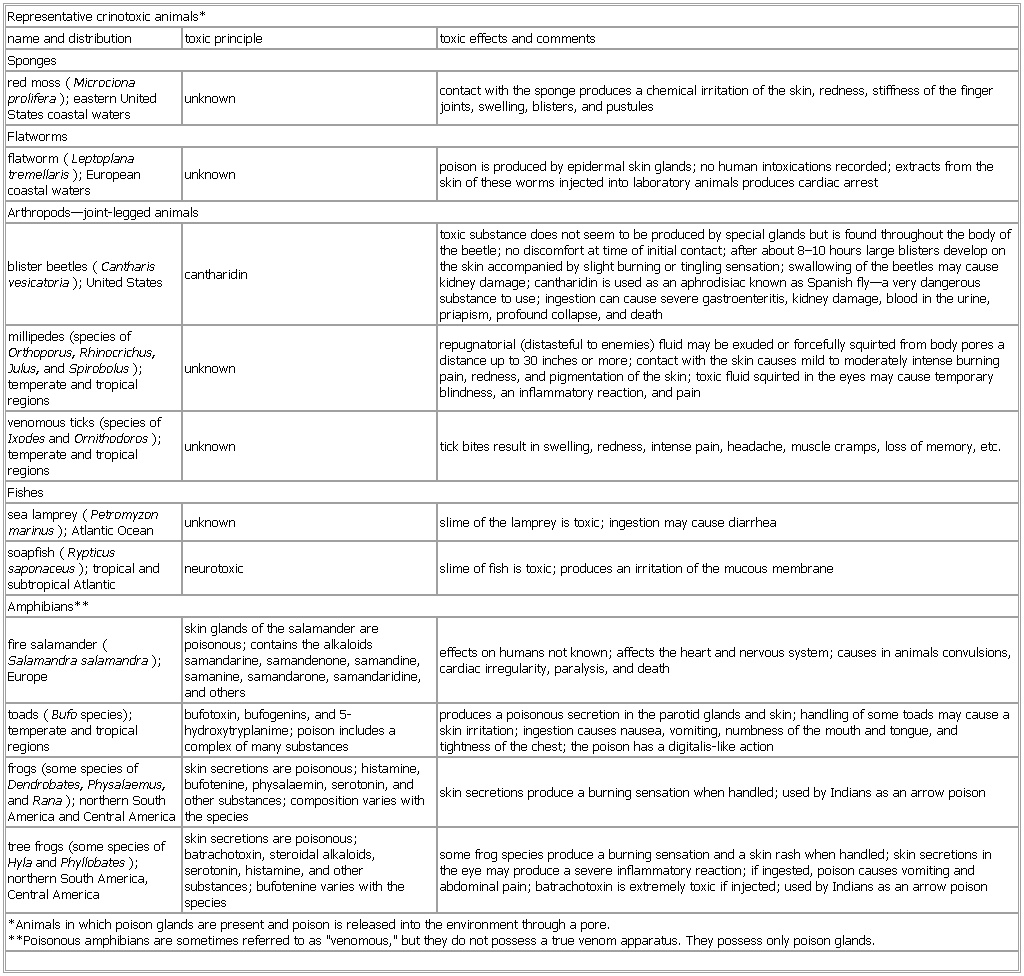- Representative crinotoxic animals
-
▪ TableRepresentative crinotoxic animals*name and distribution toxic principle toxic effects and commentsSpongesred moss (Microciona prolifera); eastern United States coastal waters unknown contact with the sponge produces a chemical irritation of the skin, redness, stiffness of the finger joints, swelling, blisters, and pustulesFlatwormsflatworm (Leptoplana tremellaris); European coastal waters unknown poison is produced by epidermal skin glands; no human intoxications recorded; extracts from the skin of these worms injected into laboratory animals produces cardiac arrestArthropods—joint-legged animalsblister beetles (Cantharis vesicatoria); United States cantharidin toxic substance does not seem to be produced by special glands but is found throughout the body of the beetle; no discomfort at time of initial contact; after about 8–10 hours large blisters develop on the skin accompanied by slight burning or tingling sensation; swallowing of the beetles may cause kidney damage; cantharidin is used as an aphrodisiac known as Spanish fly—a very dangerous substance to use; ingestion can cause severe gastroenteritis, kidney damage, blood in the urine, priapism, profound collapse, and deathmillipedes (species of Orthoporus, Rhinocrichus, Julus, and Spirobolus); temperate and tropical regions unknown repugnatorial (distasteful to enemies) fluid may be exuded or forcefully squirted from body pores a distance up to 30 inches or more; contact with the skin causes mild to moderately intense burning pain, redness, and pigmentation of the skin; toxic fluid squirted in the eyes may cause temporary blindness, an inflammatory reaction, and painvenomous ticks (species of Ixodes and Ornithodoros); temperate and tropical regions unknown tick bites result in swelling, redness, intense pain, headache, muscle cramps, loss of memory, etc.Fishessea lamprey (Petromyzon marinus); Atlantic Ocean unknown slime of the lamprey is toxic; ingestion may cause diarrheasoapfish (Rypticus saponaceus); tropical and subtropical Atlantic neurotoxic slime of fish is toxic; produces an irritation of the mucous membraneAmphibians**fire salamander (Salamandra salamandra); Europe skin glands of the salamander are poisonous; contains the alkaloids samandarine, samandenone, samandine, samanine, samandarone, samandaridine, and others effects on humans not known; affects the heart and nervous system; causes in animals convulsions, cardiac irregularity, paralysis, and deathtoads (Bufo species); temperate and tropical regions bufotoxin, bufogenins, and 5-hydroxytryplanime; poison includes a complex of many substances produces a poisonous secretion in the parotid glands and skin; handling of some toads may cause a skin irritation; ingestion causes nausea, vomiting, numbness of the mouth and tongue, and tightness of the chest; the poison has a digitalis-like actionfrogs (some species of Dendrobates, Physalaemus, and Rana); northern South America and Central America skin secretions are poisonous; histamine, bufotenine, physalaemin, serotonin, and other substances; composition varies with the species skin secretions produce a burning sensation when handled; used by Indians as an arrow poisontree frogs (some species of Hyla and Phyllobates); northern South America, Central America skin secretions are poisonous; batrachotoxin, steroidal alkaloids, serotonin, histamine, and other substances; bufotenine varies with the species some frog species produce a burning sensation and a skin rash when handled; skin secretions in the eye may produce a severe inflammatory reaction; if ingested, poison causes vomiting and abdominal pain; batrachotoxin is extremely toxic if injected; used by Indians as an arrow poison*Animals in which poison glands are present and poison is released into the environment through a pore.**Poisonous amphibians are sometimes referred to as "venomous," but they do not possess a true venom apparatus. They possess only poison glands.See as table:

* * *
Universalium. 2010.
